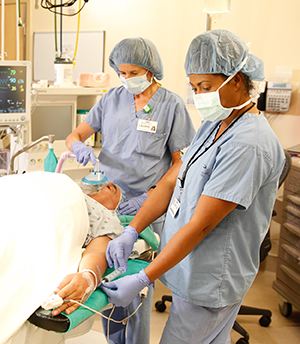Anesthesia: General Anesthesia
Anesthesia: General Anesthesia

What is general anesthesia?
General anesthesia puts you into a state like deep sleep. It goes into the bloodstream (IV anesthetics), into the lungs (gas anesthetics), or both. You feel nothing during the procedure. You will not remember it. During the procedure, the anesthesia provider monitors you continuously. He or she checks your heart rate and rhythm, blood pressure, breathing, and blood oxygen.
IV anesthetics. IV anesthetics are given through an IV line in your arm. They’re often given first. This is so you are asleep before a gas anesthetic is started. Some kinds of IV anesthetics relieve pain. Others relax you. Your doctor will decide which kind is best in your case.
Gas anesthetics. Gas anesthetics are breathed into the lungs. They are often used to keep you asleep. They can be given through a facemask or a tube placed in your larynx or trachea (breathing tube).
If you have a facemask, your anesthesia provider will most likely place it over your nose and mouth while you’re still awake. You’ll breathe oxygen through the mask as your IV anesthetic is started. Gas anesthetic may be added through the mask.
If you have a tube in the larynx or trachea, it will be inserted into your throat after you’re asleep.
Anesthesia tools and medicines
You will likely have:
IV anesthetics. These are put into an IV line into your bloodstream.
Gas anesthetics. You breathe these anesthetics into your lungs, where they pass into your bloodstream.
Pulse oximeter. This is a small clip that is attached to the end of your finger. This measures your blood oxygen level.
Electrocardiography leads (electrodes). These are small sticky pads that are placed on your chest. They record your heart rate and rhythm.
Blood pressure cuff. This reads your blood pressure.
Risks and possible complications
General anesthesia has some risks. These include:
Breathing problems
Nausea and vomiting
Sore throat or hoarseness (usually temporary)
Allergic reaction to the anesthetic
Irregular heartbeat (rare)
Cardiac arrest (rare)
Anesthesia safety
Follow all instructions you are given for how long not to eat or drink before your procedure.
Be sure your doctor knows what medicines and drugs you take. This includes over-the-counter medicines, herbs, supplements, alcohol or other drugs. You will be asked when those were last taken.
Have an adult family member or friend drive you home after the procedure.
For the first 24 hours after your surgery:
Do not drive or use heavy equipment.
Do not make important decisions or sign legal documents. If important decisions or signing legal documents is necessary during the first 24 hours after surgery, have a trusted family member or spouse act on your behalf.
Avoid alcohol.
Have a responsible adult stay with you. He or she can watch for problems and help keep you safe.
Updated:
October 08, 2017
Sources:
Overview of anesthesia and anesthetic choices, Up To Date
Reviewed By:
Image reviewed by StayWell art team.,MMI board-certified, academically-affiliated clinician,Sudheendra, Deepak, MD,Taylor, Wanda, RN, PhD